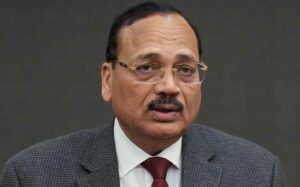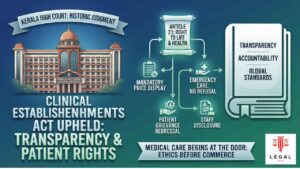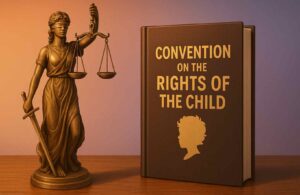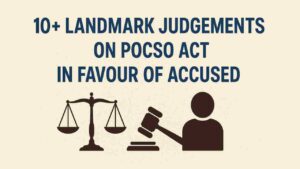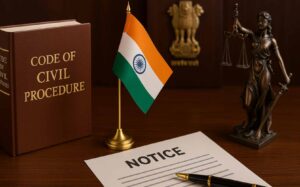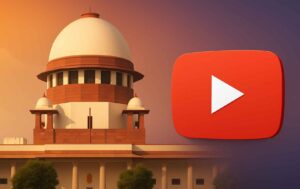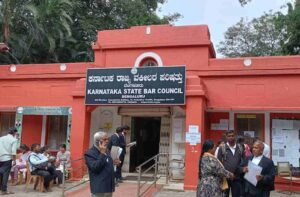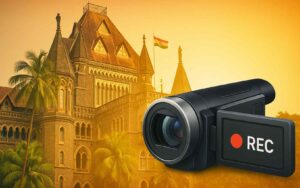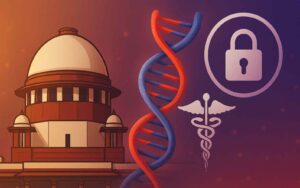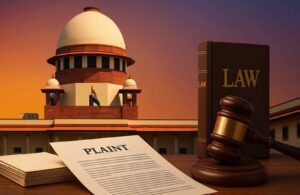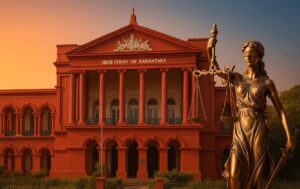A Special Leave Petition (SLP) in India allows a party to seek special permission from the Supreme Court to appeal against a judgment of a lower court. Filed under Article 136 of the Constitution, SLP is discretionary and applicable in cases of significant legal importance.
The Supreme Court of India is the guardian of the Constitution and the final arbiter in the country’s legal disputes.
Among the extraordinary powers granted to it is the ability to grant special leave to appeal from any judgment, decree, determination, sentence, or order of any court or tribunal in the territory of India.
This power is embodied in Article 136 of the Constitution and is an essential tool for ensuring that justice is not denied merely because of technicalities or limitations in the lower courts.
- Special Leave Petition (SLP): An SLP is not a right but a privilege, a discretionary remedy granted by the Supreme Court when exceptional circumstances or a substantial question of law are involved.
- Article 136: Vests in the Supreme Court the authority to entertain appeals from any judicial or quasi-judicial decision in India, except those from courts or tribunals dealing with matters relating to the Armed Forces.
- Purpose: SLPs serve as a safety valve in the judicial system, allowing the highest court to correct errors, ensure uniform interpretation of the law, and safeguard fundamental rights.
In what follows, we explore the origins, legal framework, and practical implications of SLPs, along with landmark cases that provide critical insights into the exercise of this extraordinary power.
What is a Special Leave Petition (SLP)?
A Special Leave Petition, or SLP, is a legal tool that allows an individual to approach the Supreme Court of India seeking justice when all other legal avenues have been exhausted. It’s often filed in response to a significant legal issue or a perceived miscarriage of justice.
The key feature of an SLP is that it’s not a matter of right; it’s a matter of the Supreme Court’s discretion. The Court carefully evaluates whether the case merits its attention and can deny the petition without offering any explanation. If the Court decides to grant leave, the SLP then transforms into a regular appeal and proceeds accordingly.
SLPs serve as a final legal recourse, and the Supreme Court’s decision to entertain them depends on whether there’s a compelling legal question or evident injustice. While Article 136 of the Constitution provides the basis for SLPs, it’s considered a constitutional remedy, one that the Supreme Court has acknowledged as integral to ensuring justice.
Interestingly, the threshold for accessing justice through SLPs can sometimes be relaxed when read in conjunction with other constitutional provisions. For instance:
- Article 32 allows individuals to directly move the Supreme Court for the enforcement of their fundamental rights. This includes remedies like Habeas Corpus, Mandamus, Prohibition, Certiorari, and Quo Warranto.
- Article 131 gives the Supreme Court original jurisdiction in cases involving disputes between states or between the Center and one or more states—typically involving issues of national or constitutional significance.
Together, Articles 32, 131, and 136 create a strong constitutional framework that ensures access to justice and the protection of rights, even in the most complex or exceptional cases.
Historical Evolution of Special Leave Petitions
The concept of “special leave to appeal” was not conceived in a vacuum. Its origins can be traced to the provisions of the Government of India Act, 1935.
Under this Act, the expression “special leave” was used in several sections to allow appeals on questions of law that were considered particularly important.
Although the Act set out mechanisms for appeals, it was the framers of the Indian Constitution who adapted and refined the concept for the newly independent nation.
Drafting of Article 112 and the Adoption of Article 136
During the Constituent Assembly debates, several drafts were proposed regarding the appellate jurisdiction of the Supreme Court.
Initially introduced as Draft Article 112, the provision was designed to empower the Supreme Court to grant special leave to appeal in cases where the lower courts had not provided a remedy for a grave miscarriage of justice or where a substantial question of law was involved.
After extensive debate, this provision was amended and adopted as Article 136 of the Constitution of India, 1950.
Debates over the Drafting of 136
When the Indian Constitution was being drafted, one of the big questions was just how much power the Supreme Court should have when it comes to hearing appeals. This led to some important debates in the Constituent Assembly.
On One Side: Expanding Judicial Authority
Some members, like K.T. Shah and Alladi Krishnaswami Ayyar, strongly believed that the Supreme Court should have the power to step in whenever justice hadn’t been done, no matter what level of court the case came from. Their idea was that the Court shouldn’t just be the top of the legal ladder, but a true guardian of justice, especially when someone’s fundamental rights were at stake. In their view, the Court needed a broad authority to correct serious errors and ensure fairness.
On the Other Side: Guarding Against Misuse
But there were others, including Dr. B.R. Ambedkar, who were more cautious. They worried that giving the Supreme Court too much power might backfire. If the Court could hear appeals from every case, it might end up swamped with requests, even in routine matters that lower courts are fully capable of handling. That, they argued, would slow down justice instead of speeding it up.
In the end, the Assembly found a middle path. That’s how Article 136 came into the picture. This article gives the Supreme Court the discretionary power to grant special leave to appeal against decisions from any court or tribunal in India (except military courts). This means that the Supreme Court can step in, but only when it feels that the case truly deserves its attention. It’s not an automatic right; it’s a safety valve for exceptional situations where other legal remedies have failed.
Legal Framework of Special Leave Petition under Article 136
The full text of Article 136 is as follows:
Article 136 – Special leave to appeal by the Supreme Court:
(1) Notwithstanding anything in this Chapter, the Supreme Court may, in its discretion, grant special leave to appeal from any judgment, decree, determination, sentence, or order in any cause or matter passed or made by any court or tribunal in the territory of India.
(2) Nothing in clause (1) shall apply to any judgment, determination, sentence, or order passed or made by any court or tribunal constituted by or under any law relating to the Armed Forces.
Explanation of Key Clauses
- Clause (1): Discretionary Power: The Supreme Court’s power under Article 136 is inherently discretionary. This means that the court is not bound to hear every appeal that comes before it; rather, it may choose to grant leave only in cases that present exceptional circumstances. It is a safeguard designed to ensure that only matters of substantial importance or clear injustice are escalated to the highest court.
- Clause (2): Exclusion for Armed Forces: This clause explicitly excludes decisions made by courts or tribunals established under laws relating to the Armed Forces. The rationale behind this exclusion is to maintain the specialized nature of military justice, which is governed by different principles and procedures.
Genesis of Special Leave Petition (SLP)
The concept of Special Leave to Appeal, as found in Article 136(1) of the Indian Constitution, traces its origins back to the Government of India Act, 1935. This was the first time the term “special leave” was formally introduced in Indian legal parlance.
The phrase “special leave” appeared multiple times, specifically in Sections 110, 205, 206, and 208 of the 1935 Act, each laying the groundwork for the appellate framework that would later inspire Article 136.
- Section 110(b)(iii) made it clear that legislative bodies could not override His Majesty’s prerogative to grant special leave to appeal, preserving a critical check in the judicial process.
- Section 205(2) allowed parties to appeal to the Federal Court on significant legal grounds without requiring special permission from His Majesty-in-Council. However, it restricted direct appeals to the Privy Council, regardless of whether special permission was granted.
- Section 206(1)(b) empowered the Federal Legislature to permit appeals to the Federal Court in certain civil cases, provided that special leave was granted by the Federal Court itself.
- Furthermore, Section 206(2) allowed for the abolition of direct appeals to His Majesty-in-Council, should the rules under Section 206(1) come into effect.
- Section 208 governed appeals to His Majesty-in-Council, allowing them in original jurisdiction cases either without leave or with consent, depending on the circumstances.
The term “special leave” specifically referred to the permission granted by the Judicial Committee of the Privy Council to hear such appeals.
In essence, the framework established by the Government of India Act, 1935 laid the historical and legal foundation for the present-day Special Leave Petition system under Article 136. It carried forward the principle of exceptional appellate intervention, but redefined it in the context of India’s independent judicial architecture.
Scope and Applicability of Special Leave Petition Under Article 136
Article 136 of the Indian Constitution is one of those rare provisions that gives the Supreme Court a truly extraordinary power. It allows the Court to grant special leave to appeal against any decision, whether it’s a judgment, order, sentence, or determination, made by any court or tribunal in India. What makes this so powerful is that it overrides any other rules about appeals in the Constitution. It’s like a constitutional backdoor, but one that’s kept under tight control.
Now, this doesn’t mean everyone gets an automatic ticket to the Supreme Court. That’s a common misconception. Article 136 allows you to request special leave, not the right to appeal. The Court can simply say “no,” and it doesn’t even have to give a reason.

The scope is broad; it covers everything from civil disputes to criminal cases, from final judgments to temporary orders, and even includes tribunals that act in a quasi-judicial manner. But when it comes to criminal cases, the Court is extra cautious.
If lower courts have already looked at the evidence and come to the same conclusion (what lawyers call “concurrent findings”), the Supreme Court usually doesn’t interfere—unless there’s something seriously wrong, like a blatant miscarriage of justice, violation of natural justice, or a legal error that can’t be ignored.
Over the years, the Court has made it clear: it doesn’t want to turn into a regular court of appeal for every case. It saves this power for exceptional situations, like when a decision affects a big constitutional issue, a widespread legal principle, or someone’s fundamental rights.
In fact, the Court has gone out of its way to resist setting strict rules around how and when it will use Article 136. In the 1954 case Dhaneshwari Cotton Mills v. CIT, a Constitution Bench said this power is so special that its very nature limits how often it should be used. It’s a reminder that just because the power exists doesn’t mean it should be used all the time.
Fast forward to 2016, in Mathai Joby v. George, the Supreme Court reaffirmed this idea. It said Article 136 is meant to be a constitutional safety valve—used wisely, rarely, and only when truly needed. But when justice is being denied, the Court has said it won’t let technicalities stand in the way of setting things right.
Article 136 is broad in scope and extends to:
- Judicial Decisions: It covers judgments, decrees, orders, sentences, or determinations passed by any court in India.
- Tribunals: The power also applies to decisions made by tribunals or quasi-judicial bodies that exercise a part of the judicial power.
- Both Civil and Criminal Matters: SLPs can be filed in both civil and criminal cases, though the Supreme Court is generally more cautious in reviewing criminal findings of fact.
Distinction from Other Appeals
It is crucial to distinguish an SLP from other forms of appeals:
- Right to Appeal vs. Discretionary Leave: Unlike appeals from High Courts (which are generally a right under Articles 132, 133, or 134), an SLP is a matter of privilege. The aggrieved party does not have an automatic right to be heard; the Supreme Court’s decision to grant leave is entirely discretionary.
- Certificate of Fitness: In many cases, a party must first secure a certificate from a High Court declaring that a substantial question of law is involved before proceeding with an appeal. However, an SLP bypasses this requirement, allowing a direct approach to the Supreme Court in exceptional circumstances.
Eligibility Criteria For Filing a Special Leave Petition
Before filing an SLP, the aggrieved party must ensure that:
- All Other Remedies Are Exhausted: Typically, the petitioner must have exhausted all available remedies in the lower courts.
- Time Limits Are Met: Generally, an SLP must be filed within 90 days from the date of the High Court’s judgment. If the SLP is against an order refusing to grant a certificate of fitness for appeal, it must be filed within 60 days.
- Substantial Question of Law or Gross Injustice Exists: The petition must clearly establish that a substantial question of law is involved or that a gross injustice has occurred.
Documentation and Filing Requirements
An SLP must be meticulously prepared. Key components include:
- Title and Jurisdiction: Clearly identify the parties, the lower court’s decision, and the jurisdiction under which the SLP is being filed.
- Statement of Facts: A concise yet detailed account of the relevant facts and procedural history.
- Grounds of Appeal: Elaborate on the substantial questions of law or manifest injustice that justify the Supreme Court’s intervention.
- Annexures: Attach certified copies of the judgment or order being appealed against, along with any other relevant documents or affidavits.
- Verification: The petition must be verified by the petitioner and signed by an Advocate-on-Record (AoR) registered with the Supreme Court.
How to File a Special Leave Petition Under Article 136?

The process typically unfolds in the following stages:
- Drafting the Petition: Legal practitioners draft the SLP carefully, ensuring all material facts and legal arguments are well-articulated.
- Submission to the Registry: The petition is filed at the Supreme Court registry along with the prescribed filing fee.
- Admission Hearing: The Supreme Court conducts an admission hearing where it reviews the petition to decide whether to grant leave. At this stage, the court may pass a brief order dismissing the petition (either speaking or non-speaking) or admit it for full consideration.
- Notice to Respondents: If leave is granted, notice is issued to the respondents, and the case is converted into an appeal. The respondents then have the opportunity to file a counter-affidavit.
- Detailed Hearing: Once the appeal is formally admitted, the case is heard on its merits, and the Supreme Court exercises its appellate jurisdiction.
Discretionary Nature of Special Leave Petitions
The Supreme Court’s Discretion
The power to grant special leave under Article 136 is inherently discretionary. This means that:
- No Automatic Right: An aggrieved party does not have an absolute right to be heard; the decision rests solely on the Supreme Court’s evaluation.
- Exceptional Circumstances: The Court is expected to exercise this power only in exceptional cases where a significant question of law is at stake or where there has been a manifest injustice.
- Avoiding Overburden: By exercising discretion, the Supreme Court ensures that its docket is not clogged with routine appeals, thereby preserving its resources for cases of national importance.
Factors Considered by the Supreme Court
In deciding whether to grant leave, the Court examines several factors, including:
- Substantial Question of Law: The petition must raise a question of law that has broader implications beyond the parties involved.
- Manifest Injustice: Evidence of gross miscarriage of justice or error in the interpretation of the law.
- Consistency of Precedent: Whether there is a need for uniformity in the interpretation of legal principles across different jurisdictions.
- Impact on Fundamental Rights: Whether the decision under appeal affects the fundamental rights of the parties or has wider social and legal implications.
- Quality of the Record: The completeness and reliability of the record on which the lower court’s decision is based.
Guidelines and Self-Imposed Restrictions
Over the years, the Supreme Court has developed certain informal guidelines to govern the exercise of its discretion:
- Sparing Use of Power: The Court has repeatedly stated that the power under Article 136 must be exercised sparingly and only in cases of exceptional circumstances.
- No Fettering of Discretion: The Court has resisted attempts by lower courts or legal commentators to establish a rigid formula for determining when special leave should be granted.
- Merits of the Case: In cases where leave is granted, the Court meticulously examines whether the legal issue is indeed one of substantial public importance or if the lower court’s decision is fatally flawed.
Landmark Case Laws on Special Leave Petitions
#1 Pritam Singh v. The State (1950)
In one of the earliest cases, the Supreme Court in Pritam Singh v. The State (AIR 1950 SC 169) laid down the foundational principle that the power under Article 136 is to be exercised only in exceptional circumstances.
The Court clarified that an SLP is not an appeal as a matter of right and must be granted only when a substantial question of law is involved.
Significance:
- Established that the SLP mechanism is a residual power.
- Emphasized the need for strict scrutiny before granting leave.
#2 Kunhayammed v. State of Kerala (2000)
In Kunhayammed v. State of Kerala (2000) 245 ITR 360 (SC), the Court examined the threshold for granting SLPs and reiterated that the power must be exercised with caution.
The judgment underscored that an SLP is not intended to be a routine means of appeal but a remedy reserved for cases involving exceptional legal issues or gross injustice.
Significance:
- Reinforced the discretionary nature of Article 136.
- Set parameters for identifying when an SLP is maintainable.
#3 Smt. Tej Kumari v. CIT (2001)
In Smt. Tej Kumari v. CIT (2001) 247 ITR 210, the Supreme Court clarified that the dismissal of an SLP does not necessarily imply that the impugned judgment is correct.
The Court also explained that the doctrine of merger (whereby the grounds of appeal merge into the judgment upon dismissal of the petition) does not apply to dismissed SLPs.
Significance:
- Prevented the automatic binding nature of dismissed SLPs.
- Ensured that the rejection of an SLP does not preclude further legal recourse if warranted by subsequent developments.
#4 N. Suriyakala v. A. Mohandoss (2007)
In N. Suriyakala v. A. Mohandoss & Ors (2007) 9 SCC 196, the Court held that Article 136 does not create an ordinary appellate forum. Instead, it is a discretionary power to be used only in rare and exceptional cases to address gross injustice or significant questions of law.
Significance:
- Affirmed that SLP is not a regular appeal mechanism.
- Highlighted the exceptional nature of the power, reinforcing its sparing use.
#5 Jamshed Hormusji Wadia v. Board of Trustees, Port of Mumbai (2004)
Overview:
In Jamshed Hormusji Wadia v. Board of Trustees, Port of Mumbai (2004) AIR 2004 SC 1815, the Supreme Court reiterated that the power under Article 136 is plenary and discretionary.
The Court emphasized that while it could grant leave in cases of manifest injustice or significant legal questions, such power must not be misused to override the finality of lower court decisions without proper justification.
Significance:
- Clarified the two-stage nature of SLP proceedings—first as an exercise of discretion and later as an appellate review.
- Set a benchmark for cases involving large public interest or complex legal issues.
#6 Mathai @ Joby v. George (2010)
In Mathai @ Joby v. George ((2010) 4 SCC 358), the Supreme Court took a progressive view on the scope of Article 136.
The Court maintained that it should not artificially restrict its jurisdiction under Article 136 by rigidly adhering to procedural formalities when substantial justice was at stake.
Significance:
- Expanded the interpretative ambit of Article 136 in cases involving significant questions of law.
- Emphasized the need for the Court to use its inherent powers to rectify errors in lower court judgments.
Additional Landmark Judgments
Other notable cases that have contributed to the jurisprudence on SLPs include:
- Tirupati Balaji Developers Pvt. Ltd. v. State of Bihar (2004): Addressed complex commercial disputes and raised significant questions regarding taxation and regulatory procedures.
- Columbia Sportswear Company v. Directorate of Income Tax (2011): Explored the interplay between statutory provisions and constitutional rights, particularly in relation to taxation.
- Recent Developments: In cases involving death sentences or fundamental rights, the Court has ruled that SLPs should not be summarily dismissed without detailed reasoning.
Criticisms and Controversies Surrounding Special Leave Petitions
- Backlog of Cases: One of the major criticisms is that the SLP mechanism has, at times, been misused. The Supreme Court’s docket is inundated with thousands of SLPs every year, many of which are considered frivolous or are filed on minor issues. Critics argue that this not only burdens the Court but also dilutes its focus on cases of genuine national importance.
- Frivolous Filings: There is also concern that the discretionary nature of Article 136 sometimes encourages forum shopping, where litigants file SLPs in the hope that the Supreme Court will correct a perceived error, even when the case does not raise a substantial question of law.
The Discretionary Dilemma
- Subjectivity of the Power: The inherent subjectivity in deciding which cases merit the Supreme Court’s intervention has led to debates about consistency and fairness.
- Lack of a Uniform Test: Legal scholars have long debated whether there should be a uniform test or set of guidelines for granting special leave. While the Court has maintained flexibility, this absence of formal guidelines has attracted criticism regarding transparency and accountability.
Proposals for Reform
In light of these concerns, several proposals have been put forward:
- Establishment of an SLP Board: Creating an independent body to screen and filter SLPs before they reach the Supreme Court could help ensure that only petitions raising substantial questions of law or manifest injustice are considered.
- Codification of Criteria: Codifying the standards for granting special leave might reduce subjectivity and increase transparency, though it must be balanced against the need for judicial flexibility.
- Stricter Scrutiny of Frivolous Cases: Imposing penalties on parties filing frivolous SLPs could deter abuse of the mechanism and streamline the Court’s docket.
Impact on the Indian Judicial System
- Overturn lower court decisions with legal errors or clear injustices.
- Ensure consistent law interpretation and application nationwide.
- Protect citizens’ fundamental rights in critical cases.
- Deliver landmark judgments to shape constitutional law.
- Address issues like taxation, property rights, administrative law, and criminal justice.
- Promote uniform judicial principles across India.
- Focus on meritorious cases to reduce the court backlog.
- Use e-filing and digital tools to improve efficiency.
- Ensure transparency in discretionary power to maintain public trust.
Practical Tips for Practitioners Filing an SLP
- Present facts clearly, concisely, and chronologically.
- Articulate substantial legal questions or injustices precisely, supported by case law and statutes.
- Summarize why the Supreme Court should intervene.
- Include certified copies of the challenged judgment or order.
- Attach affidavits to verify facts and enhance credibility.
- Show that all lower court remedies have been exhausted.
- File within 90 days of the High Court judgment or 60 days for certificate refusal cases.
- Support petition with relevant landmark judgments.
- Anticipate and counter arguments that issues are minor or final.
- Highlight broader societal impact for cases with substantial legal questions.
- Collaborate with senior advocates or constitutional experts.
- Have draft reviewed by peers or mentors to meet Supreme Court standards.
Recent Developments and Trends in SLP Jurisprudence
Recent trends indicate that the Supreme Court is more cautious in SLPs involving high-stakes issues such as death sentences and fundamental rights violations.
For instance, in cases like Babasaheb Maruti Kamble v. State of Maharashtra (2018) and Jitendra @ Jeetu v. State of Madhya Pradesh (2020), the Court has emphasized detailed scrutiny and provided reasoned judgments instead of summary dismissals.
Digitalization and E-Filing
- E-Filing Systems: The introduction of e-filing has reduced paperwork and minimized procedural delays.
- Virtual Hearings: Virtual hearings have allowed critical cases to be heard promptly despite challenges such as the COVID-19 pandemic.
Impact of COVID-19
The pandemic led to a surge in the filing of SLPs due to delays in lower courts, and it has accelerated the adoption of digital and virtual processes within the judiciary.
Trends in Landmark Judgments
Recent judgments have further clarified that only cases involving substantial questions of law or manifest injustice should be granted leave, and that dismissed SLPs do not preclude future legal challenges through other remedies.
Future Prospects for Reform
Ongoing debates include proposals to establish a preliminary screening board, codify certain criteria for granting special leave, and impose penalties for frivolous petitions—all aimed at streamlining the Supreme Court’s docket and enhancing judicial efficiency.
SLPs in India and International Perspectives
Comparison with the U.S. and Canadian Systems
Internationally, discretionary review by an apex court is not unique to India, yet significant differences exist:
- United States: The U.S. Supreme Court hears a limited number of cases each year (typically around 70–80), with discretionary review guided by strict criteria emphasizing national importance.
- Canada: The Canadian Supreme Court also exercises discretionary review with a focus on significant legal questions and maintaining a manageable docket.
Lessons for India
- Streamlining Docket Management: India can adopt measures to limit frivolous SLPs, ensuring that only cases of genuine importance reach the Supreme Court.
- Codified Guidelines: Adopting detailed internal guidelines could enhance transparency while preserving judicial flexibility.
- Balancing Access and Finality: It is essential to ensure that while litigants have access to the apex court, the finality of lower court decisions is not compromised unnecessarily.
The Need for Judicial Innovation
Procedural reforms such as establishing a screening board, using digital tools to streamline filing, and periodic reviews of its SLP process may benefit the Supreme Court.
These innovations can help ensure that the SLP mechanism continues to serve justice effectively while preventing overload.
Follow The Legal QnA For More Updates…
FAQs About Special Leave Petitions
What is a Special Leave Petition (SLP)?
A Special Leave Petition is a legal remedy under Article 136 of the Constitution of India that allows an aggrieved party to request the Supreme Court to review and hear an appeal against a judgment, decree, determination, sentence, or order of any lower court or tribunal.
Is filing an SLP a right?
No, filing an SLP is not an absolute right. It is a discretionary power of the Supreme Court, meaning the Court may choose to grant or dismiss the petition based on the merits of the case.
What are the time limits for filing an SLP?
Typically, an SLP must be filed within 90 days from the date of the High Court’s judgment. In cases challenging an order refusing to grant a certificate of fitness for appeal, the time limit is 60 days.
What documents must accompany an SLP?
An SLP must be supported by a certified copy of the judgment or order being appealed against, affidavits verifying the facts, and any other relevant documents that substantiate the petition.
Can an SLP be filed in criminal cases?
Yes, SLPs can be filed in both civil and criminal cases. However, the Supreme Court generally exercises greater caution in reviewing criminal findings of fact unless there is a manifest error or gross injustice.
What is the difference between an SLP and a writ petition?
A writ petition is a remedy available under Article 32 of the Constitution for the enforcement of fundamental rights, whereas an SLP is a discretionary appeal mechanism under Article 136 for reviewing decisions of lower courts or tribunals.
Verdict
Special Leave Petitions under Article 136 of the Constitution of India represent a cornerstone of the nation’s judicial system—a mechanism designed not to serve as an ordinary appeal but as a remedy for exceptional cases where there is a substantial question of law or a gross miscarriage of justice.
Landmark judgments such as Pritam Singh v. The State, Kunhayammed v. State of Kerala, Smt. Tej Kumari v. CIT, N. Suriyakala v. A. Mohandoss, Jamshed Hormusji Wadia v. Board of Trustees, and Mathai @ Joby v. George have helped shape the contours of this extraordinary power.
While the discretionary nature of Article 136 ensures that the Supreme Court’s docket remains focused on matters of significant public importance, challenges such as judicial backlog and potential misuse underscore the need for continuous review and reform.
Digital innovations and procedural reforms offer hope that the SLP process will become more efficient while continuing to safeguard the rights of citizens.
For litigants, the SLP is a vital last resort—a mechanism that provides an opportunity to correct errors when all other avenues have been exhausted.
For legal practitioners, mastering the nuances of drafting and filing an SLP is essential, as the success of such petitions often depends on the strength of the legal arguments and the clarity of the record.
Ultimately, Article 136 not only embodies the extraordinary power of judicial review but also reinforces the fundamental principle that justice must be accessible, fair, and uniformly applied across all levels of the judiciary.
References
- Constitution of India, Article 136.
- Drishti Judiciary, LawBhoomi, iPleaders, and Xperts Legal articles on SLPs.
- Landmark Judgments: Pritam Singh v. The State (AIR 1950 SC 169); Kunhayammed v. State of Kerala (2000) 245 ITR 360; Smt. Tej Kumari v. CIT (2001) 247 ITR 210; N. Suriyakala v. A. Mohandoss (2007) 9 SCC 196; Jamshed Hormusji Wadia v. Board of Trustees (2004) AIR 2004 SC 1815; Mathai @ Joby v. George ((2010) 4 SCC 358).
- Recent Developments in Death Penalty Cases: Babasaheb Maruti Kamble v. State of Maharashtra (2018); Jitendra @ Jeetu v. State of Madhya Pradesh (2020).
- Comparative Perspectives on Discretionary Review in the U.S. and Canada.


